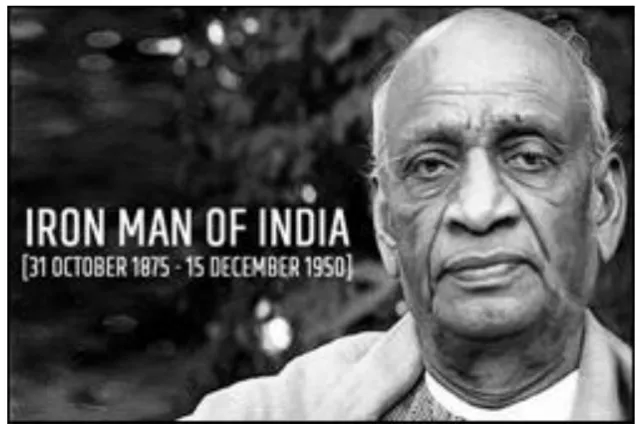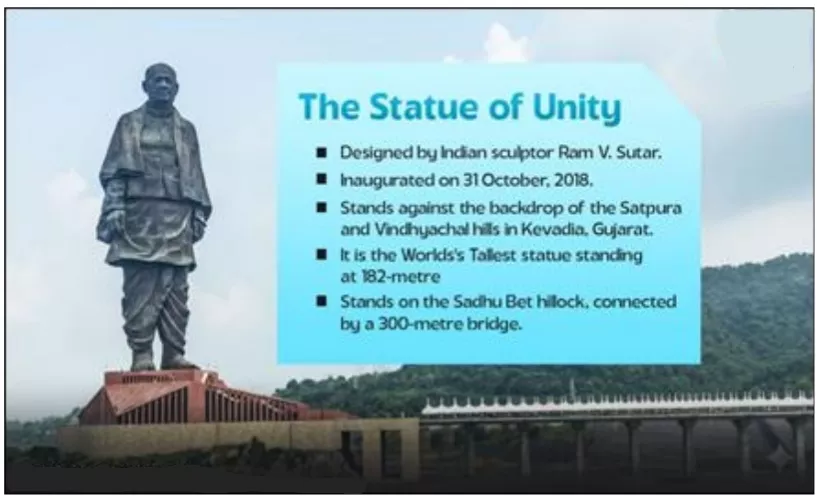Recently, the President of India paid tributes to Sardar Vallabhbhai Patel on his 150th birth anniversary at Rashtrapati Bhavan.
More on News (National Unity Day- Rashtriya Ekta Diwas)

- Observed on October 31 to honour Sardar Vallabhbhai Patel’s vision of a united India and the ideal of “Unity in Diversity.”
- Green Mobility: Flagged off electric buses for eco-friendly transport in the Statue of Unity region.
- Statue of Unity (182 m): World’s tallest statue, symbolising Patel’s decisive leadership and national unity.
- Infrastructure Boost (₹280 crore): New projects in Ekta Nagar to enhance tourism and civic facilities around the Statue of Unity.
About Sardar Vallabhbhai Patel

- Early Life and Education: Born on 31 October 1875 in Nadiad, in present Gujarat state , Patel studied law in England and became a successful barrister in Ahmedabad.
- Known for his fairness, courage, and organizational skills, he soon became a respected public leader.
- Political Journey: A senior Congress leader, Patel played a vital role in shaping India’s pre- and post-Independence politics.
- His administrative firmness balanced Gandhi’s idealism and Nehru’s vision, providing stability and realism to India’s freedom movement.
His Major Contributions
- Pre-Independence Contributions:
- Early Political Involvement: Patel first rose to prominence during the Kheda Satyagraha (1917), where he led farmers against unjust taxation during a famine, earning public trust as a firm yet fair leader.
- Non-Cooperation Movement (1920–22): He mobilized thousands to boycott British goods and promote Khadi, linking economic self-reliance with national pride.
- Bardoli Satyagraha (1928): Patel spearheaded the movement against a steep land-tax increase; its peaceful success earned him the title “Sardar” (leader).
- Civil Disobedience and Salt March (1930): He actively supported the Salt Satyagraha and was imprisoned, symbolizing his unflinching commitment to non-violent resistance.
- Indian National Congress Leadership: As INC President (1931) at Karachi, he ratified the Gandhi-Irwin Pact and moved key resolutions on Fundamental Rights and Economic Policy, which later shaped the Constitution.
- Quit India Movement (1942): Patel rallied the nation with his organisational skill and resilience even as he faced imprisonment, strengthening mass participation in the final phase of the freedom struggle.
- Post-Independence Contributions:
- Integration of Princely States (1947–50): As India’s first Home Minister and Deputy Prime Minister, Patel united over 560 princely states through a blend of persuasion, assurance, and decisive action.
- Junagadh (1948): Joined India after a public referendum.
- Hyderabad (1948): Integrated through Operation Polo after the Nizam refused accession.
- This swift and firm approach prevented India’s balkanisation and ensured territorial continuity.
- Creation of the Indian Administrative Service (IAS): He established the IAS and IPS as a replacement to ICS, calling them the “Steel Frame of India” — a non-partisan, ethical, and efficient bureaucracy crucial for nation-building.
- Rehabilitation of Refugees: After Partition, he oversaw massive relief operations and resettlement programmes, restoring stability and public confidence during a time of chaos.
- Police and Judicial Reforms: Patel strengthened internal security and modernized law-enforcement institutions, laying the base for India’s home administration system.
- Framework for Unified Governance: Beyond territorial merger, he built a common administrative structure linking Centre and States, which continues to support India’s federal system.
- Patel’s Role in India’s Integration:
- Diplomatic Negotiation: Most rulers joined India through Patel’s calm persuasion and offers of Privy Purses and constitutional protection.
- Firm Action Where Needed: He used force only when diplomacy failed, as in Junagadh and Hyderabad, to protect national interest.
- Precedent for Kashmir: Though handled by Nehru, Patel’s integration model set the tone for managing complex accessions.
- Outcome: He prevented India’s disintegration and established a strong, centralised Union that still defines the nation’s territorial map.
Key Positions Held by Sardar Vallabhbhai Patel
| Year(s) |
Position / Office |
Major Contributions / Impact Keywords |
| 1931 |
President, Indian National Congress (Karachi Session) |
Ratified Gandhi–Irwin Pact; introduced resolutions on Fundamental Rights and National Economic Policy, setting foundations for constitutional ideals. |
| 1946–1950 |
Deputy Prime Minister of India |
Second in command to Nehru; guided integration of princely states and stabilised governance post-independence. |
| 1947–1950 |
Minister of Home Affairs |
Unified over 560 princely states; ensured internal security and law & order after Partition; established India’s Home Ministry framework. |
| 1947–1950 |
Minister for States and Information |
Headed the States Department with V.P. Menon used diplomacy and firmness to integrate Junagadh, Hyderabad, and others into the Union. |
| 1947–1949 |
Chairman, Advisory Committee on Fundamental Rights, Minorities and Tribal Areas (Constituent Assembly) |
Drafted critical constitutional safeguards; balanced unity with diversity; protected minority and tribal rights. |
| 1948–1950 |
Founder of the Indian Administrative Service (IAS) & Indian Police Service (IPS) |
Created the Steel Frame of India — a professional, apolitical civil service to ensure administrative unity and national cohesion. |
| 1950 |
Acting Prime Minister (brief period) |
Led the government during Nehru’s illness; upheld continuity, discipline, and stability in administration. |
- Economic and Social Reforms:
- Farmer Empowerment: Patel led the Kheda (1918) and Bardoli (1928) Satyagrahas, defending peasants against unfair taxation during famine. His leadership gave farmers political voice and moral confidence, strengthening India’s agrarian foundation.
- Cooperative Movement Pioneer: He promoted the idea of collective self-reliance through cooperatives like Amul in Kaira district. This became a model for rural development and the White Revolution, empowering producers and reducing exploitation.
- Decentralized Economic Vision: Patel’s economic philosophy emphasized village self-sufficiency, small-scale industries, and ethical wealth distribution. He believed progress must rest on hard work, integrity, and community welfare.
- Industrial and Labour Harmony: He urged cooperation between labour and management, favouring negotiation over confrontation. His balanced approach laid the base for India’s industrial peace and disciplined workforce.
- Social Integration and Equality: Patel viewed national unity and communal harmony as essential to social progress. His humane handling of refugee rehabilitation after Partition ensured stability, dignity, and inclusivity in a fractured nation.
- Administrative and Fiscal Discipline: A strong advocate of financial prudence and clean governance, he promoted efficient administration, honesty, and accountability as the pillars of India’s economic reconstruction.
Legacy and Guiding Principles
| Principle |
Modern Relevance |
| Pragmatism and Realism |
Encourages result-oriented governance rooted in national interest. |
| Unity in Diversity |
Promotes inclusivity and harmony in a plural society. |
| Integrity and Ethical Conduct |
Strengthens trust and accountability in administration. |
| Decisive Leadership |
Ensures firmness in decision-making for national stability. |
| Administrative Neutrality |
Upholds professionalism and continuity in public service. |
His Relevance for the Contemporary World
- National Unity and Social Cohesion: Patel’s vision of “Ek Bharat, Shreshtha Bharat” remains crucial in today’s polarized world.
- His emphasis on unity in diversity guides India’s response to regionalism, communalism, and identity-based politics, reinforcing national integration in the age of global fragmentation.
- Ethical and Accountable Governance: His insistence on integrity, discipline, and public accountability continues to define India’s administrative ethics.
- The All India Services, his “steel frame of governance,” symbolize impartiality and efficiency—principles vital for digital-era governance and citizen trust.
- Pragmatic and Decisive Leadership: Patel’s balanced use of persuasion and firmness offers lessons for modern policymakers handling crises, diplomacy, and public policy challenges.
- His pragmatic realism is a model for evidence-based decision-making in today’s complex governance systems.
- Cooperative and Competitive Federalism: Patel’s belief in a strong yet collaborative Centre resonates in India’s cooperative federalism model, where Centre–State coordination drives national goals—from health and education to digital and green transitions.
- Inclusive Economic Vision: His commitment to self-reliance, fiscal prudence, and cooperative development aligns with contemporary goals of Atmanirbhar Bharat, local entrepreneurship, and equitable growth through digital inclusion and financial technology.
- Guiding Principles for the Digital and AI Era: Patel’s vision of disciplined administration and ethical leadership is deeply relevant in the AI-driven governance age.
- His emphasis on human judgment, accountability, and moral responsibility cautions against over-reliance on algorithms.
- In a world shaped by data, automation, and misinformation, Patel’s principles call for using technology to empower citizens, not control them.
- His ideals echo in today’s drive for Digital India, where governance must balance innovation with ethics, and efficiency with equity.
- Global Lessons for Statecraft: Patel’s model of unity through strength and inclusion serves as a blueprint for global governance, where ethical leadership, institutional discipline, and pragmatic cooperation are needed to counter populism, instability, and digital divides.
Awards and Honours of Sardar Vallabhbhai Patel
- Bharat Ratna (1991): Conferred posthumously in 1991 for his extraordinary role in unifying India and establishing an efficient administrative framework.
- Sardar Patel National Police Academy (Hyderabad): Named in his honour for his pivotal role in creating the Indian Police Service (IPS); it stands as a premier training institute upholding his ideals of discipline, integrity, and national service.
- International and Memorial Recognitions: His legacy is immortalised through the Statue of Unity — the world’s tallest statue (182 m) in Gujarat — and numerous institutions and universities bearing his name. Statues across the UK, USA, and Canada reflect his global influence as the architect of India’s unity.
- Sardar Patel National Unity Award: It was instituted by the Government of India in 2019 as the highest civilian award for exceptional contribution to the cause of the unity and integrity of India.
|
Rashtriya Ekta Diwas — A Pillar of National Cohesion
- Observed on: October 31 each year, commemorating Sardar Vallabhbhai Patel’s birth anniversary.
- Institutionalised in: 2014, to celebrate Patel’s role in uniting over 560 princely states and fostering “Unity in Diversity.”
- Theme (2025): Sardar@150 – Ek Bharat, Shreshtha Bharat.
- Significance:
-
- Reinforces the values of national unity, inclusivity, and patriotism envisioned by Sardar Patel.
- Bridges historical remembrance with contemporary participation through digital outreach and citizen engagement.
- Extends Patel’s message from commemoration to civic action, making national integration a living movement, not a ceremonial event.
Ek Bharat Shreshtha Bharat- Continuing Patel’s Vision
- The Ek Bharat Shreshtha Bharat (EBSB) initiative, launched by the Indian Prime Minister on October 31, 2015, reflects Patel’s enduring legacy.
- Aim: To promote cultural, linguistic, and emotional integration among India’s diverse states and union territories through structured exchanges and citizen participation.
- Core Objectives:
- Strengthen emotional bonds among citizens.
- Promote appreciation for India’s cultural diversity.
- Encourage inter-state interaction and sharing of best practices.
- Foster linguistic harmony and cross-cultural learning.
- Key Initiatives under EBSB:
- Bhasha Sangam App: Enables citizens to learn 100+ sentences across 22 Indian languages, promoting linguistic inclusivity.
- Yuva Sangam and EBSB Clubs: Facilitate student exchanges and youth interactions between paired states.
- Kashi Tamil Sangamam: Celebrates the deep spiritual and cultural connections between northern and southern India.
- Digital Integration: Platforms like My Bharat and the EBSB Portal document and promote inter-state activities, cultural showcases, and youth programs — extending the unity movement to the digital space.
Unity in the AI Age
- Rashtriya Ekta Diwas has evolved into a digital movement through the EBSB Portal and My Bharat Platform, connecting citizens across India.
- In the AI and digital governance era, Patel’s ideals of ethical leadership, administrative unity, and national integrity offer guiding principles.
- Technology should strengthen, not divide — a vision that echoes Patel’s emphasis on disciplined governance and national service.
- Digital platforms now carry forward his mission by fostering virtual collaboration, civic engagement, and digital inclusivity.
|
Conclusion
Sardar Vallabhbhai Patel transformed India from a divided colonial entity into a unified, sovereign, and administratively coherent nation. He was the architect of both India’s political map and its ethical governance framework. In today’s era of globalization, regionalism, and digital disruption, Patel’s ideals of unity, discipline, integrity, and pragmatic leadership remain vital for ensuring that India’s diversity continues to thrive under one national vision.
![]() 31 Oct 2025
31 Oct 2025




